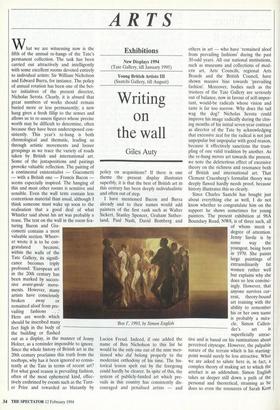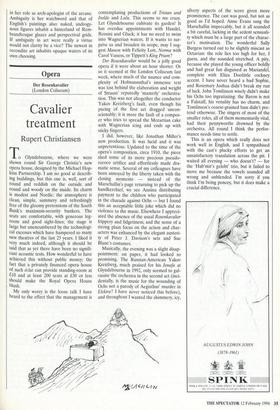ARTS
Exhibitions
New Displays 1994 (Tate Gallery, till January 1995) Young British Artists III (Saatchi Gallery, till August)
Writing on the wall
Giles Auty
What we are witnessing now is the fifth of the annual re-hangs of the Tate's permanent collection. The task has been carried out attractively and intelligently with some excellent rooms devoted entirely to individual artists: Sir William Nicholson and Edward Burra, for instance. The policy of annual rotation has been one of the bet- ter initiatives of the present director, Nicholas Serota. Clearly, it is absurd that great numbers of works should remain buried more or less permanently; a new hang gives a fresh fillip to the senses and allows us to re-assess figures whose precise worth may be difficult to determine, often because they have been underexposed con- sistently. This year's re-hang is both chronological and thematic, leading us through artistic movements and looser groupings as we trace the variety of roads taken by British and international art. Some of the juxtapositions and pairings provoke valuable reflection. The pairing of a continental existentialist — Giacometti — with a British one — Francis Bacon seems especially inspired. The hanging of this and most other rooms is sensitive and sensible. Even the wall texts contain less contentious material than usual, although I think someone must wake up soon to the realisation that a good deal of what Whistler said about his art was probably a tease. The text on the wall in the room fea-
valuable section. Whoev- er wrote it is to be con- gratulated because, within the walls of the Tate Gallery, its signifi- cance becomes triply profound: 'European art in the 20th century has been marked by succes-
sive avant-garde move-
ments. However, many artists have consciously broken away or remained aloof from pre- vailing fashions . . .'
Here are words which should be inscribed many feet high in the body of the building or flashed out as a display, in the manner of Jenny Holzer, as a reminder impossible to ignore. Since the whole history of British art in the 20th century proclaims this truth from the rooftops, why has it been ignored so consis- tently at the Tate in terms of recent art? For what good reason is prevailing fashion, often of the most ephemeral kind, effec- tively enshrined by events such as the Turn- er Prize and rewarded so blatantly by policy on acquisitions? If there is one theme the present display illustrates superbly, it is that the best of British art in this century has been deeply individualistic and often out of step.
I have mentioned Bacon and Burra already and to their names would add painters of the first rank such as Walter Sickert, Stanley Spencer, Graham Suther- land, Paul Nash, David Bomberg and 'Box l, 1993, by Simon English Lucien Freud. Indeed, if one added the name of Ben Nicholson to this list he would be the only one out of the nine men- tioned who did belong properly to the modernist orthodoxy of his time. The his- torical lesson spelt out by the foregoing could hardly be clearer. In spite of this, the system of publicly-funded art which pre- vails in this country has consistently dis- couraged and penalised artists — and
others in art — who have 'remained aloof from prevailing fashions' during the past 30-odd years. All our national institutions, such as museums and collections of mod- ern art, Arts Councils, regional Arts Boards and the British Council, have shown massive bias towards 'prevailing fashion'. Moreover, bodies such as the trustees of the Tate Gallery are seriously out of balance, now in favour of self-impor- tant, would-be radicals whose vision and taste is far too narrow. Why does the tail wag the dog? Nicholas Serota could improve his image radically during the clos- ing months of his initial seven-year contract as director of the Tate by acknowledging that excessive zeal for the radical is not just unpopular but unpopular with good reason, because it effectively sanctions the tram- pling of one valid tradition by another. As the re-hang moves art towards the present, we note the deleterious effect of excessive theory on the richness and resonance both of British and international art. That Clement Craenberg's formalist theory was deeply flawed hardly needs proof, because history illustrates this so clearly.
der's art is
superficially attrac- tive and is based on his ruminations about perceived cityscape. However, the palpable nature of the terrain which is his starting- point would surely be less attractive. What we are asked to salute here is, in fact, a complex theory of making art to which the artefact is an addendum. Simon English takes us deeper still down a path of the personal and theoretical, straining as he does so even the resources of Sarah Kent
in her role as arch-apologist of the arcane. Ambiguity is her watchword and that of English's paintings also: naked, androgy- nous figures inhabit a hinterland of Rem- brandtesque glazes and perspectival grids. If ambiguity in art were really a virtue would not clarity be a vice? The newest in recondite art inhabits opaque waters of its own choosing.



















































 Previous page
Previous page